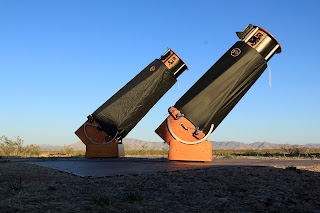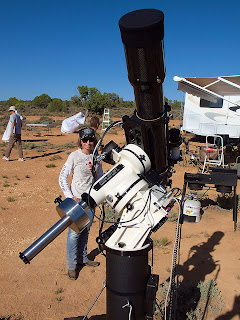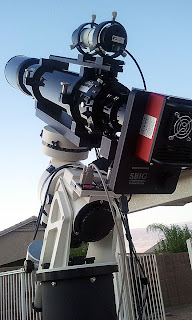PEMPro-V2
- A quick routine is used to determine the camera’s orientation (position angle) and the calibration of North/South/East/West to the X/Y coordinates of the camera chip. Typically this takes me about 2 minutes.
- PEMPro will measure a star near 0º declination and near the meridian by taking repeated subexposures and measuring the star’s drift over a period of time. Typically, I do this for 7 minutes.
- After selecting a star in the star field, PEMPro will draw an arrow and a circle over the frame and begin taking repeated images of the field. Using the azimuth adjustment you simply adjust the mount east/west until the star is in the circle drawn.
- Altitude is then set by moving 45º relative (east or west) to the meridian and repeating the 7 minute measuring phase.
- After selecting a star in the star field, center it in the superimposed circle using only the altitude adjustment on the mount.
- Repeat if necessary.
Maxim DL
 Maxim DL is one of those suite software appllications that tries to be all things to all people and it does a pretty good job of it. Nearly everything that has anything to do with data acquisition goes through Maxim DL in my setup. I use Maxim DL to control the telescope and the camera through every phase of capturing data. I use Maxim DL to:
Maxim DL is one of those suite software appllications that tries to be all things to all people and it does a pretty good job of it. Nearly everything that has anything to do with data acquisition goes through Maxim DL in my setup. I use Maxim DL to control the telescope and the camera through every phase of capturing data. I use Maxim DL to:- Align the telescope at the beginning of the evening. Using the built-in PinPoint LE astrometry software after polar alignment I can sync the telescope to a plate solved field and I’m done. Ready to slew anywhere in the sky.
- Slew the telescope. Using the built in catalogs I’ll slew the telescope to the chosen object. An automated exposure is taken after a slew and plate solved to ensure that I’m exactly centered on the field.
- Focus the telescope. Sort of. I use Maxim DL to tweak the Moonlite focuser during a filter change to the appropriate offset for the filter being selected. Real focusing chores are handled by FocusMax – which uses the camera control in Maxim DL to do it's thing.
- Guide the telescope. I use Maxim’s built in guiding capabilities to autoguide during subexposures.
- Full camera control including temperature regulation, switching filters, taking exposures and moving the telescope slightly to dither between exposures.
- Capture of calibration frames. Dark, bias and flat frames are all taken with Maxim DL. Soon I’ll be working to configure Maxim to automate flats through each filter using an Optec FlatMan. Stay tuned for more on that.
- Maxim DL does an excellent job of controlling the telescope to correctly capture the multiple frames needed for a mosaic.
- I use DDP in Maxim DL during an evening just to preview what kind of data I’m capturing.
- Maxim DL has many other built in features for calibrating, stacking and processing images. While they’re effective I have found that there are other tools that I like better for those tasks.
PixInsight
 PixInsight completely changed the way that I process images. It’s software developed by astrophotographers specifically for the purpose of processing astrophotos. It has gotten a bad rap by people who haven’t thoroughly investigated the product saying that the learning curve is steep and that educational resources are lacking. I’ll agree that it’s a different approach to processing than most people are used to, but if you take the time to use the resources that are available it’s quite intuitive. I use it for nearly all of my calibration, stacking and image processing. The 800 pound gorilla known as PhotoShop still figures in to my image processing scheme for some final tweaks, but 95% of my workflow after I capture an image is done with this application. I use it to:
PixInsight completely changed the way that I process images. It’s software developed by astrophotographers specifically for the purpose of processing astrophotos. It has gotten a bad rap by people who haven’t thoroughly investigated the product saying that the learning curve is steep and that educational resources are lacking. I’ll agree that it’s a different approach to processing than most people are used to, but if you take the time to use the resources that are available it’s quite intuitive. I use it for nearly all of my calibration, stacking and image processing. The 800 pound gorilla known as PhotoShop still figures in to my image processing scheme for some final tweaks, but 95% of my workflow after I capture an image is done with this application. I use it to:- Create master bias, dark and flat frames. Here’s a tutorial on the creation of master calibration frames.
- Calibrate, Register and Stack a series of light frames. It takes more effort in PixInsight than in other applications but the end result is a much cleaner master light frame in my experience. I stopped using Maxim DL’s calibration & stacking routines after the first using PixInsight’s methods just once.
- All image processing tasks including color calibration, background neutralization, stretching, contrast enhancement and teasing out detail in the image.

PhotoShop CS5
 The heavyweight of all image processing packages is without question Adobe’s PhotoShop. I once used it for everything I did in a stacked image but it has fallen very much by the wayside since I picked up PixInsight. In all fairness though, I do still use it at the very end of my workflow to do some final background smoothing, perhaps an Unsharp Mask and to resize/save the image for publishing on the web. There are a lot of resources available to learn how to process an image with PhotoShop. I found Adam Block’s DVD “Making Every Pixel Count” to be the best among them. I’ve since met Adam and had an opportunity to pick his brain on a couple of things. He’s a gracious guy who’s more than willing to share his extensive knowledge. Check out one of his imaging workshops if you want some hands on experience with him.
The heavyweight of all image processing packages is without question Adobe’s PhotoShop. I once used it for everything I did in a stacked image but it has fallen very much by the wayside since I picked up PixInsight. In all fairness though, I do still use it at the very end of my workflow to do some final background smoothing, perhaps an Unsharp Mask and to resize/save the image for publishing on the web. There are a lot of resources available to learn how to process an image with PhotoShop. I found Adam Block’s DVD “Making Every Pixel Count” to be the best among them. I’ve since met Adam and had an opportunity to pick his brain on a couple of things. He’s a gracious guy who’s more than willing to share his extensive knowledge. Check out one of his imaging workshops if you want some hands on experience with him.What’s Missing?
If I had to go through the rest of my life with just the equipment and software that I have I could still die a happy man. I don’t think that I’m missing any critical piece of the puzzle any longer. But let’s face it – astrophotographers are probably the most desperate breed of astro-equipment junkies out there. Now that I have a narrowband imaging rig and could conceivably image every clear night from my backyard it appears that imaging could become a threat to sleep and my ability to conduct what normal people call a normal life. I’ll evaluate the situation before long and see if it makes sense to incorporate an automated imaging platform to handle imaging sessions for me. I’ve been quietly eyeing CCD AutoPilot to fulfill that role but I’m not a point where I’m ready to seriously take on that task just yet.
With new moon coming tomorrow I hope that the Arizona monsoon cooperates enough to allow me a solid first light with the SBIG ST-8300 and filter wheel this weekend. Once I get that incorporated into the workflow then I’ll see about the last couple of “nice to have” pieces – an off axis guider and an automated imaging platform. Until then, I continue to be a happy guy who has it far better than he deserves it.





